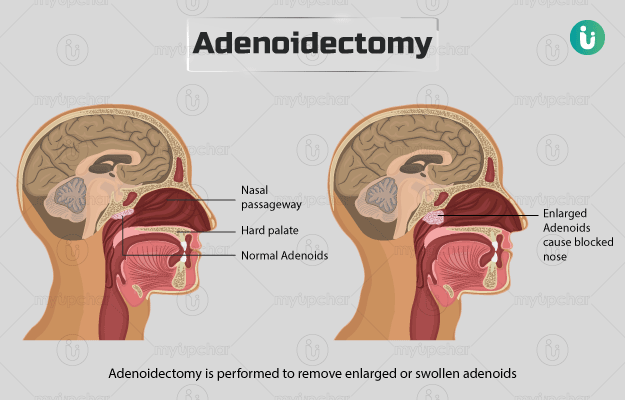Summary
Adenoidectomy is performed to remove enlarged or swollen adenoids, which are lumps of tissue located behind the nose. Normally, adenoids help fight off infections caused by bacteria and viruses, however, if they become enlarged, they will obstruct the airway, making it difficult for a person to breathe through the nose. Enlarged adenoids also cause ear infections and difficulty in sleeping at night. Therefore, adenoidectomy is usually advised for these conditions. Enlarged adenoids occur typically only in children as adenoids shrink away in adulthood. The surgery is generally performed under general anaesthesia, which puts the child to sleep during surgery. The operation takes about 30 minutes, and the child is often discharged after a few hours. It takes around two weeks for the child to recover from the surgery completely.
- What is adenoidectomy?
- Why is adenoidectomy recommended?
- Who can and cannot get adenoidectomy?
- What preparations are needed before adenoidectomy?
- How is adenoidectomy done?
- How to care for yourself after adenoidectomy?
- What are the possible complications/risks of adenoidectomy?
- When to follow up with your doctor after an adenoidectomy?
What is adenoidectomy?
An adenoidectomy refers to the surgical removal of swollen or enlarged adenoid glands.
Adenoids are small lumps of tissue situated at the back of your nose, on the upper surface of your mouth. They are a component of the defence (immune) system and help the body to fight infections caused by bacteria and viruses. The size of the adenoid glands is large during childhood, and they gradually start shrinking from the age of five to seven years. Adenoids completely disappear by adulthood.
An adenoidectomy is done if adenoids become swollen or enlarged while fighting off bacteria and viruses. This usually happens in children. A few children are also born with abnormally enlarged adenoids. When adenoids are enlarged, they tend to block the airway, causing ear infections, breathing problems, and other complications. Such conditions warrant the removal of adenoids. Studies have shown that removal of adenoids does not affect the ability of children to fight off infections.
Why is adenoidectomy recommended?
A surgeon may recommend removal of adenoids in your child if they have become enlarged and are causing the following:
- Difficulty breathing: Enlarged adenoids may block the airway, making it difficult for the child to breathe through the nose. Instead, the child breathes through the mouth, causing dry mouth and cracked lips.
- Difficulty sleeping: Difficulty in breathing may persist during sleep, resulting in a condition called sleep apnoea. This condition causes irregular breathing, choking or gasping noises, and loud snoring during sleep. The child may wake up from sleep multiple times in the night and feel sleepy during the daytime.
- Persistent or recurrent sinusitis: Sinusitis refers to the swelling of the sinuses, which are the hollow, empty spaces present behind the forehead and cheekbones that connect to the nose. Sinusitis causes facial pain and a runny nose.
- Persistent or recurrent ear problems: Swollen adenoids cause ear problems, such as ear infections and build-up of fluid inside the middle ear. These ear problems can cause ear pain, tiredness, and difficulty hearing.
The surgeon may also advise this surgery if your child has recurrent tonsillitis.
Who can and cannot get adenoidectomy?
The surgeon may not recommend this surgery or advise caution if your child has any of the following:
- Velopharyngeal insufficiency (occurs when the soft palate - back of mouth - does not properly close and the air comes out of nose)
- Cleft palate
- An active infection
- If the child tends to bruise or bleed easily
What preparations are needed before adenoidectomy?
The surgeon may first examine your child's adenoids by performing an X-ray or by placing a small camera inside his/her nose. Such imaging tests will help the doctor to look at the enlarged adenoids and decide if an adenoidectomy is indeed needed.
The surgeon may instruct the following for the preparation of the child before the surgery:
- Avoid giving medicines like blood thinners (aspirin and ibuprofen) to your child unless advised by the doctor.
- You may be asked to not give your child food or drinks to after midnight, the night before the surgery.
- You will need to sign a consent form that gives your approval for the procedure.
- The child should take medicines on the day of the procedure with minimum water.
How is adenoidectomy done?
Adenoidectomy is a simple, short procedure performed by an ear, nose, and throat (ENT) surgeon. The surgery is performed under general anaesthesia (medicines that put your child to sleep). The procedure usually involves the following steps:
- An anesthesiologist will make your child comfortable and administer general anaesthesia to him/her as a gas to breathe in or as an injection. The child will fall asleep after some time with gas, and immediately after injection.
- After this, the child will be taken to the operating room.
- The surgeon will open the child’s mouth wide using a device called a retractor.
- Next, he/she will use a tool called a curette or other similar tools to remove the child's adenoids.
- After removing the adenoids, the surgeon will use methods like electrocautery or ablation to stop the child's bleeding. In electrocautery, a device that heats up the tissue using electricity is used; while in coblation, the tissue is heated using radio waves.
The surgery takes about 30 minutes. The hospital staff will then shift your child to the recovery ward. There, your child’s temperature, pulse, and wound will be regularly monitored. The child will be discharged a few hours after surgery when they are awake and able to breathe, swallow, and cough normally.
How to care for yourself after adenoidectomy?
Your child may require one to two weeks to completely recover from the surgery. You can expect the following after surgery:
- It is normal for the child to have a sore throat after the surgery. The child will be given painkillers for the pain.
- The child may also experience the following symptoms for a few weeks:
- Stiff jaw
- Earache
- Bad breath
- Blocked nose
- Difficulty swallowing
- Difficulty brushing teeth
- Nasal discharge
These symptoms usually do not require any treatment.
- Your child will be able to eat normally soon after surgery. You may give the child a painkiller one hour before they eat to ease the swallowing of food.
- You can also give soft foods to help with the throat pain, such as scrambled eggs, mashed potatoes, smoothies, etc.
- Ask the child to drink plenty of liquids to avoid dehydration.
- Avoid giving the following foods to the child during recovery:
- Hot and spicy foods
- High-fat dairy products
- Drinks with a lot of acid in them, such as orange juice and grapefruit juice
- Rough foods, such as cold cereal and raw crunchy vegetables
- Your child may experience bad smell from their nose, which will resolve in about a week’s time. Antibiotics may be given to reduce this.
- The surgeon will ask you to avoid giving medicines containing aspirin to the child.
- The child will need to rest for about 10 days before going to school to reduce the risk of infection.
After this surgery, the child will be able to breathe properly through the nose. The child will also have fewer instances of sore throat and ear infections.
When to see the doctor?
You should contact the surgeon immediately if the child shows the following symptoms after surgery:
- Bleeding from the mouth
- Feeling shivery or hot
- High body temperature
- Not drinking any liquids
- Pain that persists even after taking medicines
- Blood in the vomit
What are the possible complications/risks of adenoidectomy?
The surgery is quite safe. The complications associated with this surgery are rare, but there is a slight chance of the following complications:
- Bleeding
- Infection
- A broken or chipped tooth
- Allergic reaction to anaesthesia
When to follow up with your doctor after an adenoidectomy?
The surgeon will inform you if the child needs a follow-up visit before being discharged from the hospital.
Disclaimer: The above information is provided purely from an educational point of view and is in no way a substitute for medical advice by a qualified doctor.
Surgery Cost In Your City
References
- Cleveland Clinic. [Internet]. Cleveland. Ohio. US; Adenoidectomy
- National Health Service [internet]. UK; Adenoidectomy
- Wetmore RF. Tonsils and adenoids. In: Kliegman RM, Stanton BF, St. Geme JW, Schor NF, eds. Nelson Textbook of Pediatrics. 20th ed. Philadelphia, PA: Elsevier; 2016:chap 383.
- Flint PW, Haughey BH, Lund V, et al, eds. Cummings Otolaryngology: Head and Neck Surgery. 6th ed. Philadelphia, PA: Elsevier Saunders; 2015:chap 195, 184.
- Miller BJ, Gupta G. Adenoidectomy. [Updated 2020 Feb 6]. In: StatPearls [Internet]. Treasure Island (FL): StatPearls Publishing; 2020 Jan
- Stanford Children's Health: Lucile Packard Children's Hospital, Stanford; Velopharyngeal Insufficiency (VPI)
- Oxford University Hospitals [internet]: NHS Foundation Trust. National Health Service. U.K.; Adenoid surgery
- Centers for Disease Control and Prevention [internet]. Atlanta (GA): US Department of Health and Human Services; Facts about Cleft Lip and Cleft Palate















